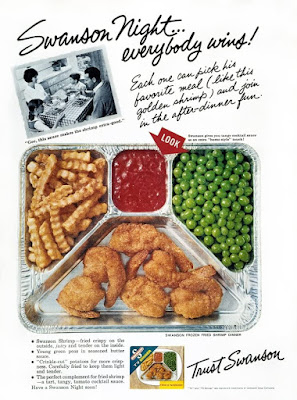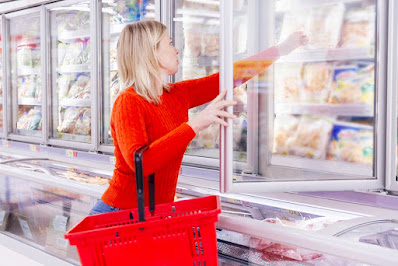National Frozen Food Day is celebrated every year on March 6, in honor of the meals and snacks in the freezer.
Two inventions enabled the realization of the great idea of food freezing: the invention of the freezer and the invention of technologies for preparing food that can be frozen.
The invention of frozen foods has greatly improved our lives. Instead of throwing away food that has become unfresh, you can freeze it indefinitely and eat it whenever you want, after bringing it back to life to be fresh with no problem!
The history of frozen food
Freezing food slows down its decay by turning excess moisture into ice and inhibits the growth of most bacterial strains. From the dawn of history, farmers, fishermen, hunters and trappers have kept their produce in unheated storage places during the winter season.
For centuries, tribes that lived in places where the climate was cold used natural food freezing. In 1885, a small number of chickens and geese were sent from Russia to London in insulated crates thanks to the use of this technique. As early as 1899 there was a developed import of frozen food from Russia to London during the 4 winter months. The imported food has been supplied to cities all over England such as Birmingham, Liverpool and Manchester. They then began to use the freezer to import meat.
In 1929, Clarence Birdseye , a U.S. government biologist, proposed to the U.S. government the "flash freeze" method of vegetables, meats, fruits and seafood to preserve the taste and quality of food. Clarence created Birdseye Seafoods products and developed the rapid freezing process that included special packaging. After winning the first patent for the frozen food freezing process in the United States in 1927, he founded Birdseye and today he and his company are considered some of the founders of the frozen food industry.
Further attempts to promote frozen food were made by Eleanor Roosevelt, the wife of US President Franklin Roosevelt, during her visit to Russia. At the end of World War II, the Allies also tried to freeze orange juice, ice cream and vegetables.
In 1945, Maxson Food Systems produced the first frozen meal. They created the "Strato-Plates" - whole meals reheated on the plane for military and civilian plane passengers. Meals included a basic three-piece equation of meat, vegetables and potatoes, each housed in its own separate compartment on a plastic plate. However, for economic reasons and the death of their founder, Maxson's frozen meals never went on the retail market.
Following Maxson Foods Systems came Jack Fisher's frozen dinners, the FridgiDinners. In the late 1940s meals were sold to bars and taverns.
In 1949, brothers Albert and Meyer Bernstein founded Frozen Dinners. They packed frozen dinners on three-compartment aluminum trays. They sold them under the label "One-Eyed Eskimo" and marketed them only in the Pittsburgh area. By 1950, the company had produced over 400,000 frozen dinners. They later expanded distribution to markets east of the Mississippi.
The concept caught on and took off from 1954 when Swanson's frozen meals appeared. Swanson invented the brand of frozen dinners in front of the TV (TV Dinners). Meals that do not require any cooking skills. Just preheat the oven and cook the frozen food for the required time.
 |
| Tv Dinner Ad 1963 (link) |
Frozen food, no matter how comfortably prepared, at that time was still heated inside the traditional oven, in a process that would have been time consuming. It was only in the early 1940s and 1950s that faster and easier heating options began to enter the picture.
In 1945, Percy Spencer, an American self-taught engineer, accidentally discovered the idea of using microwaves to heat food.
The Raytheon company he worked for bought the idea from him and registered a patent for the microwave cooking process. In 1947 the first commercial microwave oven was built.
National Frozen Food Day was founded on March 6, 1984 by President Ronald Reagan who wanted to encourage the safe development of food freezing processes. This was after microwaves became accessible to the general public during the 1970s-80s.
During these periods, grocery stores barely devoted a small portion of their sales shelves to frozen foods. Nowadays, however, stores often make room for several aisles of frozen foods from different companies that allow consumers to heat up ready-made foods in less than 30 minutes.
How to celebrate Frozen Food Day?
Frozen food day celebration can be a great opportunity to learn new things about the history of food, and also just enjoy the comforts that frozen foods bring to modern life.
Another option for celebrating frozen food day is to go out to the shops and look at the frozen food departments, see how big and rich they are and how today any food can be found in a frozen version, which was not the case fifty years ago and even less! Today, many brands and product lines have let innovation work and produced new lines of frozen food, taking into account the changing habits and nutritional requirements of the customer base. Today there are many food options like gluten free, vegan, vegetarian, kosher, halal and so on.
Learn more interesting facts about frozen foods, such as:
Freezing is the best method of preserving food. It keeps food fresher than other methods, like canning or drying.
Frozen foods are frozen at the peak of their ripening. This means that some of them may be more nutritious from "fresh" produce that has been traveling for weeks to get to the grocery store.
Nutritious foods can be enjoyed throughout the year using the freezing process, even in climates where produce does not grow well during the winter months.
Frozen foods do not require additional preservatives or sodium, making them no less healthy than fresh foods.
Food can be stored in the freezer for 3 to 8 months, depending on the type of food. Pre-frozen vegetables can be frozen for 8 months. Carrots, cabbage and beetroots can be frozen for 8-10 months. Fresh tomatoes and herbs can be frozen for two months. Fresh peppers: 6 months. Corn cob: 8 months. Bananas: 3 months, apples: 8 months, bread, rolls: 3-5 months if you put them straight into the freezer, and 2-3 weeks if you opened the package, took out a slice and returned it to the freezer.
